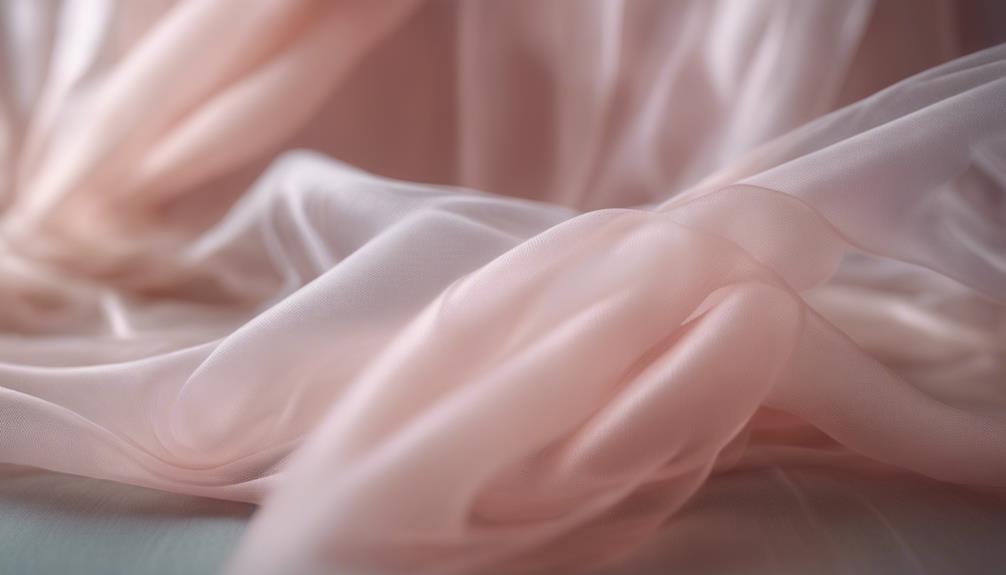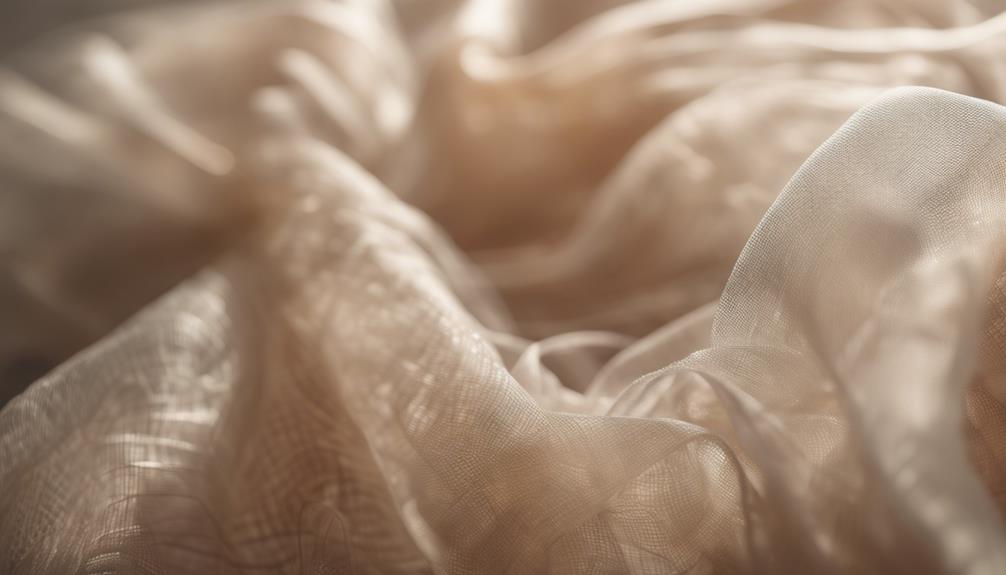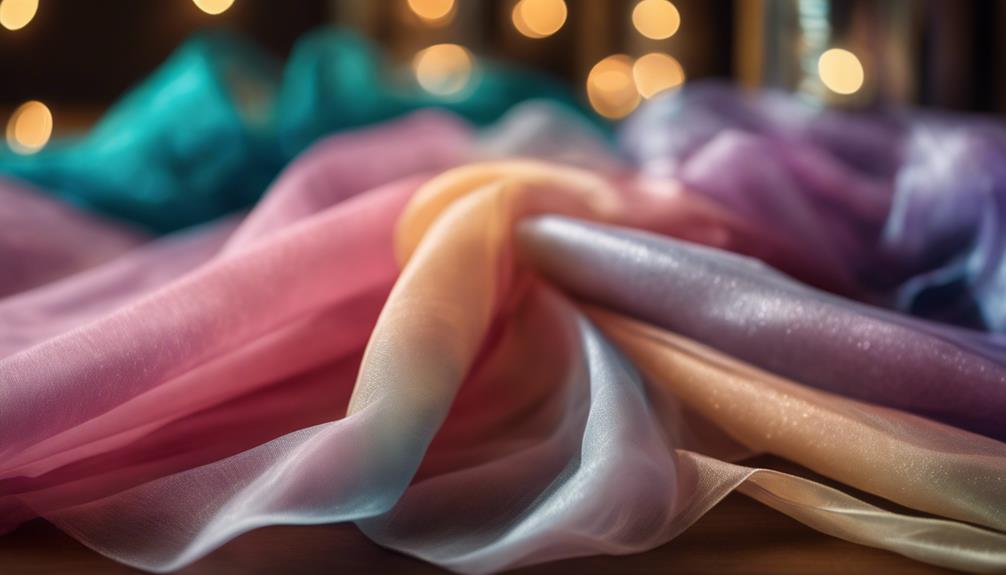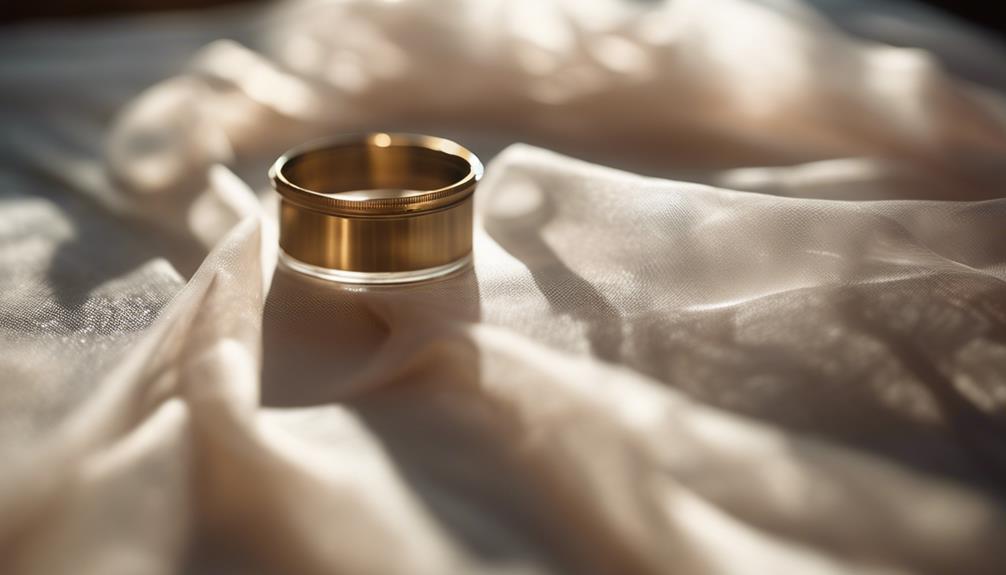To identify organza, start by checking its crisp texture; it should feel noticeably structured, unlike the softer touch of chiffon. Hold the fabric up to the light; organza is semi-transparent, allowing light to pass through. Perform the sound test by scrunching it—organza emits a distinct crisp sound. For a final check, use the fire test; silk organza smells like burnt hair, while synthetics give off a plastic odor. Understanding these characteristics will help you distinguish organza from other fabrics. There's plenty more to discover about this elegant material and its various types.
Definition and Characteristics

When you think of organza, picture a lightweight, transparent fabric that exudes elegance. This fabric is commonly made from woven threads of silk, cotton, or synthetic materials, giving it a unique appeal. One of the key characteristics of organza is its crisp texture, which contributes to its structured appearance. Unlike fabrics such as chiffon and georgette, which are softer and more fluid, organza maintains a form that enhances its decorative potential.
You'll easily recognize organza by its shiny surface and fine structure, making it a popular choice for evening dresses and accessories. When trying to identify organza, note that it is non-elastic; if it stretches, it can't be classified as organza. This rigidity allows it to create voluminous silhouettes and layered designs, perfect for special occasions.
Types of Organza
While you may be familiar with the classic organza, several types exist, each offering unique qualities and uses. One popular type is silk organza, known for its lightweight and delicate nature. This luxurious fabric boasts a bright appearance and refined texture, making it ideal for elegant garments.
If you're looking for something more durable, consider polyester organza or nylon organza. Both are widely available and provide transparent qualities, making them excellent choices for various applications, from home decor to fashion accessories.
For those who appreciate intricate designs, embroidered organza features decorative embroidery or lace motifs, adding a touch of sophistication to any project.
If structure is what you need, cotton organza might be your best bet. With a thicker texture, it's often used in wedding dresses, providing both support and a soft feel, perfect for those stunning, opaque dresses.
Each type of organza has its own distinct benefits, so understanding these options can help you choose the right fabric for your next project. Whether you want lightweight elegance or something more structured, there's a type of organza to fit your needs.
How to Identify Organza

Identifying organza can be straightforward if you know what to look for. To start, check the texture and appearance of the fabric. Real organza has a crisp texture and a shiny finish, while fake organza will feel more plastic-like. You can perform a bounce test; true organza maintains its shape without bouncing back.
Next, examine the translucency. Organza fabric should be semi-transparent, allowing some light through without being completely see-through. For a more definitive test, try the fire test. Genuine silk fibers will smell like burnt hair and leave a fine ash, while synthetic fibers emit a plastic odor.
Finally, listen for the sound it makes when scrunched. Organza produces a distinct crisp sound, unlike faux fabrics that sound more like plastic.
Here's a quick reference table to help you identify pure organza sarees:
| Feature | Real Organza | Fake Organza |
|---|---|---|
| Texture | Crisp | Plastic-like |
| Translucency | Semi-transparent | Often opaque |
| Fire Test | Burns like hair | Burns like plastic |
| Sound when scrunched | Crisp sound | Plastic sound |
| Bounce Test | Holds shape | Bounces back |
Maintenance and Care
Proper maintenance and care for organza is essential to keeping its beauty intact. This delicate fabric requires special washing instructions to preserve its pure structure. It's best to hand wash or use a delicate machine program with cold water. Avoid squeezing the organza; instead, lay it flat on a clean towel to dry. Keep it away from direct sunlight to prevent damage.
When it comes to ironing, use a low temperature and always place a protective cloth over the organza. This way, you can avoid scorching the fabric while maintaining its crisp appearance. Be sure to check the fabric label for specific washing instructions, as different types of organza—like silk, cotton, and synthetic—may have varying care requirements.
For long-term storage, store organza in a cool, dry place. Fold it carefully to avoid creases, and make certain it's kept away from moisture, which can lead to mildew. By following these maintenance tips, you can keep your organza looking beautiful and extend its lifespan, enjoying its delicate charm for years to come.
Cost and Purchasing Tips

When you're ready to buy organza, understanding the cost and your options can save you both money and frustration. The price of organza varies greatly based on the material. Silk organza can cost between 30 and 60 EUR per meter, while cotton and synthetic varieties range from 5 to 20 EUR per meter.
To guarantee you're making a wise purchase, here are some tips:
| Material Type | Price Range (EUR/meter) | Key Considerations |
|---|---|---|
| Silk Organza | 30 – 60 | High quality, check authenticity |
| Cotton Organza | 5 – 20 | Affordable, lower durability |
| Synthetic Organza | 5 – 20 | Cost-effective, varies in quality |
Always compare prices across different platforms and look for detailed product descriptions and customer reviews to verify the quality of the organza. Be cautious of prices that seem too good to be true, as they might indicate inferior quality. Finally, confirm the seller has a clear return policy to protect yourself against potential issues with the organza fabric.
Frequently Asked Questions
How to Recognize Pure Organza?
To recognize pure organza, feel its slightly coarse texture and check for translucency. When you scrunch it, listen for a crisp sound, and observe that it maintains folds without bouncing back. Trust your senses!
How Can You Tell the Difference Between Organza and Organdy?
To tell the difference between organza and organdy, feel the texture; organza's smooth and shiny, while organdy's matte and slightly coarse. Also, note organza's stiffness compared to organdy's lighter, more flowing nature.
How Can You Tell the Difference Between Organza and Chiffon?
To tell the difference between organza and chiffon, feel the textures. Organza's stiffer and crisper, while chiffon's smooth and drapable. Notice the sheen too; organza shines brighter, whereas chiffon appears softer and more delicate.
What Does Organza Look Like?
Organza looks lightweight and transparent, showcasing a crisp texture and shiny finish. You'll notice its structured appearance, often in vibrant or pastel shades. When held up, it appears translucent, letting light filter through beautifully.




